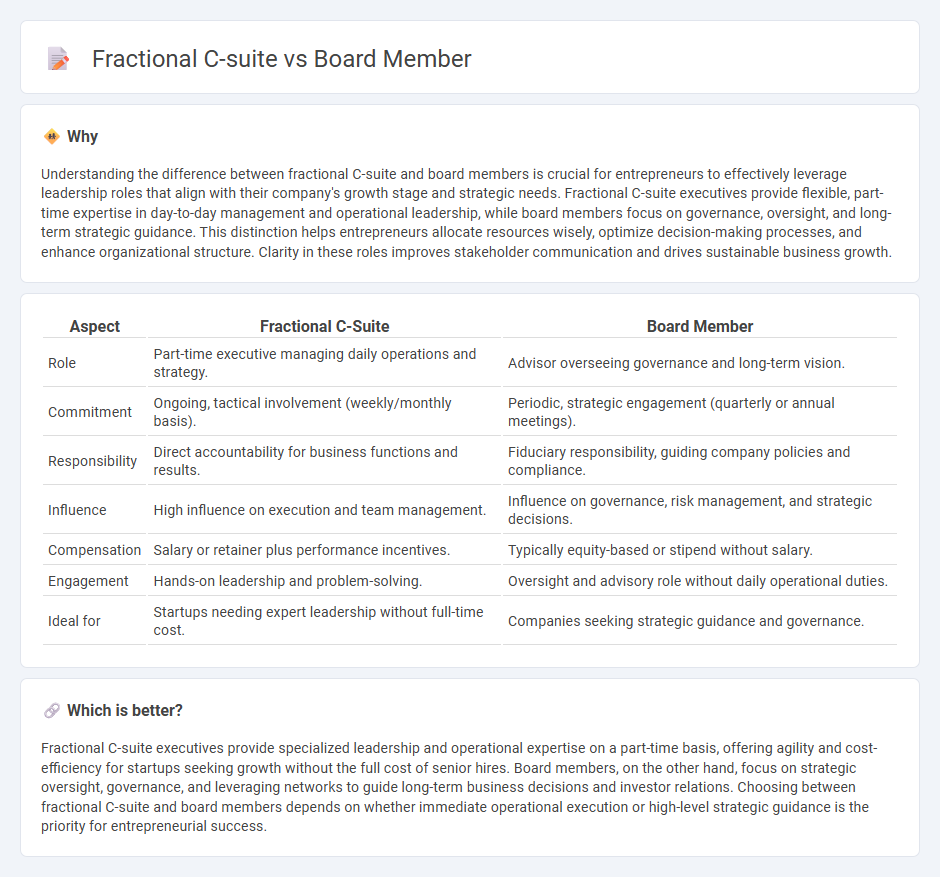
Fractional C-suite executives bring specialized leadership to startups and growing companies on a part-time basis, offering strategic guidance without the full cost of a permanent hire. In contrast, board members provide governance oversight and long-term strategic direction but typically do not engage in daily operational roles. Discover how these roles uniquely impact business growth and decision-making.
Why it is important
Understanding the difference between fractional C-suite and board members is crucial for entrepreneurs to effectively leverage leadership roles that align with their company's growth stage and strategic needs. Fractional C-suite executives provide flexible, part-time expertise in day-to-day management and operational leadership, while board members focus on governance, oversight, and long-term strategic guidance. This distinction helps entrepreneurs allocate resources wisely, optimize decision-making processes, and enhance organizational structure. Clarity in these roles improves stakeholder communication and drives sustainable business growth.
Comparison Table
| Aspect | Fractional C-Suite | Board Member |
|---|---|---|
| Role | Part-time executive managing daily operations and strategy. | Advisor overseeing governance and long-term vision. |
| Commitment | Ongoing, tactical involvement (weekly/monthly basis). | Periodic, strategic engagement (quarterly or annual meetings). |
| Responsibility | Direct accountability for business functions and results. | Fiduciary responsibility, guiding company policies and compliance. |
| Influence | High influence on execution and team management. | Influence on governance, risk management, and strategic decisions. |
| Compensation | Salary or retainer plus performance incentives. | Typically equity-based or stipend without salary. |
| Engagement | Hands-on leadership and problem-solving. | Oversight and advisory role without daily operational duties. |
| Ideal for | Startups needing expert leadership without full-time cost. | Companies seeking strategic guidance and governance. |
Which is better?
Fractional C-suite executives provide specialized leadership and operational expertise on a part-time basis, offering agility and cost-efficiency for startups seeking growth without the full cost of senior hires. Board members, on the other hand, focus on strategic oversight, governance, and leveraging networks to guide long-term business decisions and investor relations. Choosing between fractional C-suite and board members depends on whether immediate operational execution or high-level strategic guidance is the priority for entrepreneurial success.
Connection
Fractional C-suite executives and fractional board members provide scalable leadership solutions tailored to startups and growing businesses, enabling access to high-level expertise without full-time commitments. These roles often intersect as fractional C-suite leaders bring strategic insights to the boardroom, enhancing governance and decision-making. Leveraging fractional talent promotes agility, reduces overhead costs, and aligns leadership objectives with company goals during critical growth phases.
Key Terms
Governance
Board members play a critical role in corporate governance by overseeing management decisions, ensuring regulatory compliance, and safeguarding shareholder interests. Fractional C-suite executives, while providing strategic leadership and operational expertise on a part-time basis, typically focus more on execution rather than governance oversight. Explore the distinct advantages and governance impacts of board members versus fractional C-suite roles to optimize your leadership structure.
Strategic Oversight
Board members provide strategic oversight by guiding long-term vision, ensuring governance, and safeguarding stakeholder interests without engaging in daily management. Fractional C-suite executives contribute strategic expertise on a part-time basis, driving specific initiatives and operational alignment while maintaining flexible involvement. Explore how aligning both roles can optimize your organization's strategic oversight and growth trajectory.
Operational Leadership
Board members provide strategic oversight and governance, influencing high-level decisions without direct involvement in daily operations. Fractional C-suite executives deliver hands-on operational leadership, driving execution and managing functional teams while contributing strategic insights. Explore how leveraging fractional C-suite roles enhances operational agility and board effectiveness.
Source and External Links
3 Types of Board Members (Plus 10 Types of Boards) | Indeed.com - A board member is an individual on a company's board of directors, acting as part of the organization's governing body, overseeing management, and representing shareholder interests.
Complete Guide To Board Member Responsibilities & Roles - Board members are expected to go beyond attendance, supporting the organization's mission, serving as ambassadors, and fulfilling specific leadership roles such as chairperson, who presides over meetings and sets strategic goals.
Board Member Roles and Responsibilities | BoardSource - Board members must attend meetings, stay informed about the organization, serve on committees, make personal contributions, advocate for the organization, and assist with fiduciary and governance duties.
 dowidth.com
dowidth.com